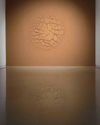
When cultural activist Pupul Jayakar was trying to set up the design centres of the All India Handloom Board in 1955, one of the persons she approached for help was the young painter K.G. Subramanyan. He readily agreed. In his essay “Do hands have a chance?” brought out in a volume to felicitate Jayakar on her 70th birthday, Subramanyan detailed what attracted him to this cause. “Though I subscribed to the idea that creative artists and craftsmen are rare and especially endowed individuals, the idea of maintaining and presenting familial traditions of refined craft practice from one generation to the next intrigued me no end.”
Subramanyan was also conscious that millions of people depended on handicrafts for their survival and that modern and mechanized systems of production – necessary for spurring a newly independent nation’s economy – posed a threat to their existence. This could push vibrant craft forms that had been flourishing for centuries to the brink of extinction. Urgent support systems were required and the Weavers’ Service Centre (WSC) set up in 1956 was one such initiative that filled that gap.
The design centres had a pan-Indian presence and were located in four zones: North, South, East and West. While some of them were in the metros, others were close to traditional weaving centres such as Varanasi, Kanchipuram, Bhagalpur and Indore. Many had both weaving and printing facilities, where master weavers adroitly translated designs into fabric.
Bu hikaye Art India dergisinin December 2019 sayısından alınmıştır.
Start your 7-day Magzter GOLD free trial to access thousands of curated premium stories, and 9,000+ magazines and newspapers.
Already a subscriber ? Giriş Yap
Bu hikaye Art India dergisinin December 2019 sayısından alınmıştır.
Start your 7-day Magzter GOLD free trial to access thousands of curated premium stories, and 9,000+ magazines and newspapers.
Already a subscriber? Giriş Yap

Parts, Wholes And The Spaces In Between
Sonal Sundararajan introduces Samira Rathod's free-spirited and rebellious explorations in the world of architecture, furniture and design.

"The Fine Art of Going to the Pictures."
Dr. Banerjee in Dr. Kulkarni's Nursing Home at Chemould Prescott Road brings together 26 paintings featuring a series of dramatic scenes from Hindi and Bengali films. In conversation with Abhay Sardesai, artist Atul Dodiya talks about childhood trips to movie halls, painted figures gripped by tension, and the closeness and remoteness of cinematic images.

"To Finally Have Something of Your Own to Mine."
Dayanita Singh is the recipient of the coveted 2022 Hasselblad Award. Keeping the photograph at the centre, she speaks to Shreevatsa Nevatia about books, book objects, photo novels, exhibitions and museums.

OF DIVINE LOSS
Shaurya Kumar explores the relationship between the subject and object of devotion, finds Aranya.

THE PAST AND ITS SHADOWS
Neha Mitra visits two shows and three artists in Mumbai.

FORCE OF NATURE
Alwar Balasubramaniam dwells on absences and ephemeralities in his new work, states Meera Menezes.

SHAPES OF WATER
Devika Sundar's works delineate the murky, malleable boundaries between the human body and the organic world, says Joshua Muyiwa.

INTIMATIONS OF INTIMACY
Sunil Gupta shares his journey with Gautami Reddy.

THE FRACTURED PROSPECT
Nocturnal landscapes as ruins in the making? Adwait Singh looks at Biraaj Dodiya's scenes of loss.

TEETERING BEYOND OUR GRASP
Meera Menezes traces Mahesh Baliga's journey from Moodabidri to London.